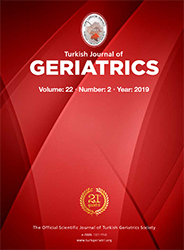Materials and Method: In total, 56 (44 female and 12 male) patients operated for hip fractures were prospectively analyzed. Clinical frailty scale was used to determine the preoperative frailty status. Nutritional Risk Screening 2002 scores were measured to examine the risk of malnutrition status. The 4 "AT" test was conducted for the diagnosis of delirium. Mortality rates were determined in the postoperative month 1.
Results: Of the total, 29 (51.8%) patients were found to be frail, 22 (39.3%) were found to be prefrail, and 5 (8.9%) were found be nonfrail. Further, 34 (60.8%) patients were at the risk of malnutrition. Additionally, 38 (67.8%) patients had delirium and 8 (14%) patients died during the postoperative month 1. Although Nutritional Risk Screening 2002 scores positively correlated with first-month mortality, no correlation was found between malnutrition and delirium status. A positive correlation was found between clinical frailty scale score and delirium; however, there was no correlation between clinical frailty scale score and firstmonth mortality. Positive predictive values of malnutrition and frailty together for first-month mortality increased up to 54.5% from 17.6% and 13.6 and that of delirium increased to 80.2% from 54.5% and 72.4%, respectively.
Conclusion: Morbidity and mortality rates can be reduced after hip fractures by detecting frailty and malnutrition together and taking necessary preoperative precautions in the elderly.
Keywords : Geriatrics; Age determination by skeleton; Forensic medicine
